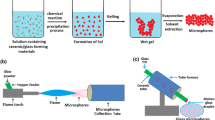Abstract
A new type of carbonate hydroxyapatite nanoparticles (CHANPs) was prepared from poly (methyl methacrylate) (PMMA) and oyster shells (OS) powder. The structure, morphology, and biocompatibility of these NPs were determined. The NPs of PMMA + 2%OS with the mean grain size of 70.50 nm were immersed in simulated body fluid (SBF) for 30 days to test its biocompatibility. The amorphous state of the as-prepared sample was confirmed from XRD analyses. After immersion in SBF, PMMA and PMMA + 2%OS sample showed polycrystalline with hexagonal structure and crystallite sizes of 29.816 and 50.61, respectively. The XRD analyses showed excellent crystallinity and SEM images displayed the formation of a HA layer on the sample’s surface. FTIR spectra revealed the existence of various chemical functional groups, and EDX spectra detected all trace elements in the sample. The observed new FTIR peak at 1090.51 cm−1 of PMMA + 2%OS sample verified the formation of CHANPs as supported by FESEM and XRD results. It was asserted that the achieved CHANPs may contribute to various biomedical applications.










Similar content being viewed by others
References
Hasan S (2015) A review on nanoparticles: their synthesis and types. Res J Recent Sci 2277:2502
Salim AA, Bakhtiar H, Bidin N, Ghoshal SK (2018) Antibacterial activity of decahedral cinnamon nanoparticles prepared in honey using PLAL technique. Mater Lett 232:183–186
Cho EJ, Holback H, Liu KC, Abouelmagd SA, Park J, Yeo Y (2013) Nanoparticle characterization: state of the art, challenges, and emerging technologies. Mol Pharm 10(6):2093–2110
Salim AA, Bakhtiar H, Ghoshal SK (2021) Improved fluorescence quantum yield of nanosecond pulse laser ablation wavelength controlled cinnamon nanostructures grown in ethylene glycol medium. Optik 244:167575
Salim AA, Bidin N, Ghoshal SK, Islam S, Bakhtiar H (2018) Synthesis of truncated tetrahedral cinnamon nanoparticles in citric acid media via PLAL technique. Mater Lett 217:267–270
Xiang L, Xiang Y, Wen Y, Wei F (2004) Formation of CaCO3 nanoparticles in the presence of terpineol. Mater Lett 58(6):959–965
Islam S, Bakhtiar H, Bidin N, Salim AA, Riaz S, Abbas KN, Naseem S (2018) Influence of ZnO doping on structural, optical and pH-stimulus characteristics of silica-titania nanocomposite matrix. J Saudi Chem Soc 22(7):826–837
Yao Z, Xia M, Ge L, Chen T, Li H, Ye Y, Zheng H (2014) Mechanical and thermal properties of polypropylene (PP) composites filled with CaCO3 and shell waste derived bio-fillers. Fibers Polym 15(6):1278–1287
Suzuki M, Sakuda S, Nagasawa H (2007) Identification of chitin in the prismatic layer of the shell and a chitin synthase gene from the Japanese pearl oyster, pinctada fucata. Biosci biotechnol biochem. https://doi.org/10.1271/bbb.70140
Sudo S, Fujikawa T, Nagakura T, Ohkubo T, Sakaguchi K, Tanaka M, Nakashima K, Takahashi T (1997) Structures of mollusc shell frameworkproteins. Nature 387:563–564
Yao Z, Xia M, Li H, Chen T, Ye Y, Zheng H (2014) Bivalve shell: not an abundant useless waste but a functional and versatile biomaterial. Crit Rev Environ Sci Technol 44(22):2502–2530
Mori K (2014) Recycling of waste oyster shells: production of clean and bactericidal drinking water. Found Oyster Res Inst pp 31 35
Salim AA, Ghoshal SK, Bakhtiar H (2021) Tailored morphology, absorption and bactericidal traits of cinnamon nanocrystallites made via PLAL method: role of altering laser fluence and solvent. Optik 226:165879
Mallick PK, Newman S, UR EDS (1990) Composite materials technology- processes and properties. New York/Munich, Oxford University Press/Hanser Publishers 1990:400
Clyne TW, Hull D (2019) An introduction to composite materials. Cambridge University Press
Cascini G, Rissone P (2004) Plastics design: integrating TRIZ creativity and semantic knowledge portals. J Eng Des 15(4):405–424
Frazer RQ, Byron RT, Osborne PB, West KP (2005) PMMA: an essential material in medicine and dentistry. J long-term eff med implants. https://doi.org/10.1615/JLongTermEffMedImplants.v15.i6.60
Hamester MRR, Balzer PS, Becker D (2012) Characterization of calcium carbonate obtained from oyster and mussel shells and incorporation in polypropylene. Mater Res 15:204–208
Prabhakar MN, Lee DW, Kim BS, Song JI (2014) Development and characterization of oyster shell powder filled polypropylene composite. Compos Res 27(5):201–206
Li L, Zeng Z, Wang Z, Peng Z, She X, Li S, Zhong J (2017) Effect of oyster shell powder loading on the mechanical and thermal properties of natural rubber/oyster shell composites. Polym Polym Compos 25(1):17–22
Ramakrishna C, Thenepalli T, Nam SY, Kim C, Ahn JW (2018) Extraction of precipitated calcium carbonate from oyster shell waste and its applications. J Energy Eng 27(1):51–58
Duan G, Zhang C, Li A, Yang X, Lu L, Wang X (2008) Preparation and characterization of mesoporous zirconia made by using a poly (methyl methacrylate) template. Nanoscale Res Lett 3(3):118–122
Hashem M, Rez MFA, Fouad H, Elsarnagawy T, Elsharawy MA, Umar A, Ansari SG (2017) Influence of titanium oxide nanoparticles on the physical and thermomechanical behavior of poly methyl methacrylate (PMMA): a denture base resin. Sci Adv Mater 9(6):938–944
Acknowledgements
Authors are extremely thankful to Universiti Teknologi Malaysia (UTM), and RMC for research grant FRGS Q.J130000.2509.21H11, 06G82, FRGS/1/2019/STG02/UTM/02/7, 04E86, FRGS 5F050, and UTMFR 21H78.
Author information
Authors and Affiliations
Corresponding author
Ethics declarations
Conflict of interest
The authors declare that they have no conflict of interest.
Additional information
Publisher's Note
Springer Nature remains neutral with regard to jurisdictional claims in published maps and institutional affiliations.
Rights and permissions
Springer Nature or its licensor (e.g. a society or other partner) holds exclusive rights to this article under a publishing agreement with the author(s) or other rightsholder(s); author self-archiving of the accepted manuscript version of this article is solely governed by the terms of such publishing agreement and applicable law.
About this article
Cite this article
Jubier, N.J., Hassani, R.H., Hathot, S.F. et al. A new type of carbonate hydroxyapatite nanoparticles made from PMMA and oyster shells: evaluation of structure, morphology and biocompatible properties. Polym. Bull. 80, 13263–13277 (2023). https://doi.org/10.1007/s00289-023-04712-w
Received:
Revised:
Accepted:
Published:
Issue Date:
DOI: https://doi.org/10.1007/s00289-023-04712-w




